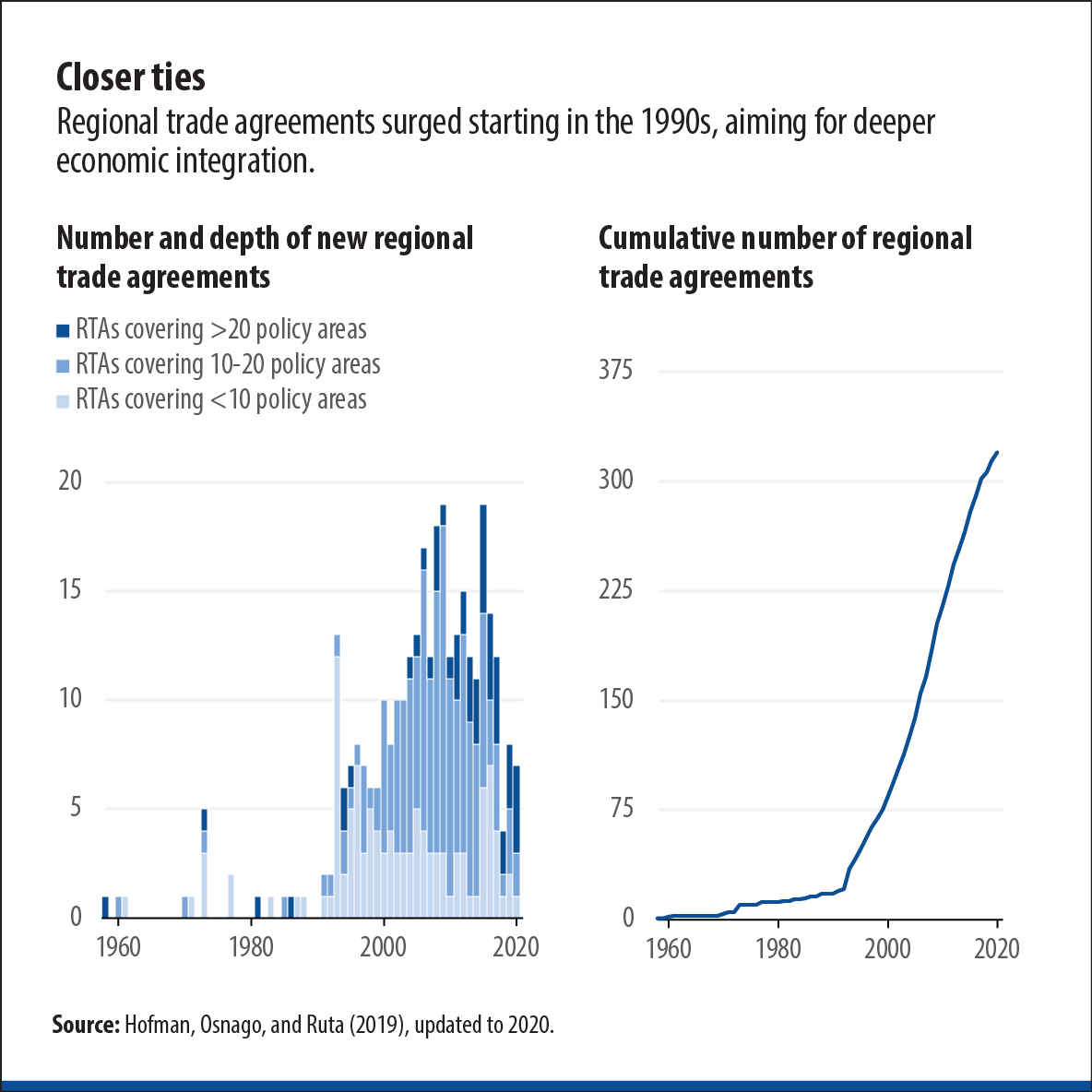At a time of growing global tensions, regional trade alliances may be less about integration and more about discrimination
For 30 years the number of regional trade agreements (RTAs) has been on the rise, from fewer than 50 in 1990 to more than 350 today. Major players such as the United States, the European Union, and China have built networks of RTAs as a flexible way of advancing economic integration. Some agreements—for example, the Comprehensive and Progressive Agreement for Trans-Pacific Partnership (CPTPP)—are “mega-regional,” with partners in Asia, Australia, and the Western Hemisphere. One of the newest, the 2018 African Continental Free Trade Agreement (AfCFTA), spans an entire continent and is the world’s largest regional trade agreement, covering more than 1.3 billion people.
RTAs have helped rewrite trade rules and reshape both trade and nontrade outcomes. Today, they address a range of policy areas and have been instrumental in reducing trade costs for all trading partners, members or not, which has helped expand multilateral integration. Beyond trade, the wave of regionalism has affected foreign investment, technological innovation, migration, labor, and environmental issues. In some cases, these agreements’ impact has been undeniably positive; in others it has not.
Many observers see regionalism and multilateralism as opposing forces. Some believe that global tensions that are weakening the multilateral trading system—including protectionism and rising nationalism—will inevitably push governments toward more and stronger regional pacts. Is that really so? And what kind of regionalism should we expect? Regionalism gained popularity during a period when the World Trade Organization (WTO) and its multilateral trade rules and adjudication processes were widely accepted—an era quite unlike that of today’s fraying trade relationships and weakened WTO.
There is an old Italian saying: “Athens cries, but even Sparta cannot laugh.” In ancient Greece, the cities of Athens and Sparta were two great rivals. It was believed that the demise of one would lead to the triumph of the other. It didn’t happen that way. After a period of turbulence, both cities succumbed to decline. Today we might say, “Multilateralism cries, but even regionalism cannot laugh." Regionalism in a time of conflict is unlikely to triumph, but rather is likely to change. What could emerge is a more discriminatory regionalism designed to increase barriers to trade with nonmembers rather than reduce them with members. This type of regionalism would be less efficient and, ultimately, weaker.
Deep, dynamic agreements
During the past 30 years there have been significant changes to RTAs. There aren’t just more of them; they are also “deeper.” Before the 1990s—with the notable exception of the European Economic Community—a typical trade agreement addressed only a handful of policy areas, mostly tariff liberalization and border issues, such as customs.
Since the 1990s, agreements (see chart) have transformed to emphasize deepening economic integration and cooperation (Mattoo, Rocha, and Ruta 2020). Today, they also address regulations and so-called nontariff measures, which once were the domain of domestic policymakers. Although agreements vary, they broadly regulate three overlapping policy areas:
- The integration of goods, services, and factor markets and rules regulating areas such as tariffs, services, investment, and intellectual property rights
- Restrictions on governments’ ability to take action that could reverse economic integration, including regulatory barriers, sanitary measures, subsidies, and rules governing competition
- Protection of rights that could be diminished by market integration if regulations governing areas such as labor or environmental standards are not upheld

Deepening integration
RTAs that have emerged during the past three decades provided the institutional framework for market integration. They helped cut trading costs and accelerate growth opportunities, particularly in developing economies (Fernandes, Rocha, and Ruta 2021). One study found that deep RTAs increased trade between members by 40 percent on average.
Despite concerns that these agreements would hinder integration with nonmembers, evidence suggests just the opposite. Many provisions in recent RTAs are nondiscriminatory and have reduced costs for members and nonmembers alike. Rules that increase competition, regulate domestic subsidies, or support the adoption of international regulatory standards in members’ markets have been found to boost exports by nonmembers.
Nontrade outcomes are affected as well. Provisions on investments, visa and asylum issues, and protection of intellectual property rights have been shown to reduce the cost of cross-border activities and lessen legal uncertainties, which in turn stimulates foreign direct investment, migration, and technology flows. One study on the effectiveness of environmental provisions in RTAs found that they prevented about 7,500 square kilometers of deforestation during 2003–14.
But RTAs have had unintended consequences as well. A study on child labor standards found that agreements that don’t include child labor provisions can reduce child employment and increase school enrollment. RTAs with child labor bans, paradoxically, can have the opposite effect: they shrink children’s wages and sometimes lead poorer households to send more of their children into the labor market to make up for the lost income.
Unseen complementarities
The difficulty in advancing WTO negotiations is surely one of the reasons RTAs have dominated the trade agenda in recent decades. But an underappreciated explanation for their success is that multilateral and regional integration complement each other in several ways.
First, the same societal segments that favor multilateral integration—exporting firms, for example—also support regional integration. Second, WTO laws and dispute mechanisms are the foundation of RTA law. Many such agreements restate countries’ existing WTO commitments and rely on that organization’s adjudication system for enforcement. Other RTAs use multilateral commitments as the basis for advancing regional integration. Third, because many RTA commitments are nondiscriminatory, they promote both regional and multilateral integration.
This level of complementarity suggests that regionalism may be weaker during times of conflict. While governments may turn to regional agreements as an alternative to WTO rules or to pursue strategic interests, that doesn’t necessarily lead to deeper RTAs. One reason is that RTA laws would rest on shakier WTO laws. Another reason is that anti-integration forces, such as import-competing sectors, would be skeptical of regional integration, just as they are skeptical of multilateral integration.
Discriminatory regionalism
Perhaps most worrisome is the danger that times of conflict could lead to RTAs that build higher walls against the outside world, rather than lower internal fences.
In the 1930s, as the global economy descended into depression and multilateral trade collapsed, a surge of protectionist measures aimed at countries outside regional blocs reshuffled trade patterns. For the UK, imports from the British Empire accounted for less than 30 percent at the beginning of the period and more than 40 percent at the end. By making trade less secure and more costly, the discriminatory regionalism of the 1930s received a great deal of blame for escalating international tensions.
Today, the trend toward strengthening ties with friends and loosening them with non-friends may reignite regional discrimination. We’ve already observed a surge of protectionist measures, such as local content requirements in subsidy programs and export restrictions targeting countries that are not regional trade partners. Stringent rules to establish the origin of a product, with the goal of increasing the regional value content in production at the expense of extraregional value content, is another example of such discrimination. These practices are contrary to the spirit, if not the letter, of multilateral trade rules and could increase integration costs and hinder efficiency.
Discriminatory regionalism may also be leveraged to achieve nontrade objectives such as ensuring higher labor and environmental standards, the adoption of domestic rather than global standards, or redirection of supply chains for national security reasons. An example is an agreement signed at the end of March between Japan and the United States on certain critical minerals, which could be the first in a number of new deals with limited scope. This agreement is very different from the deep RTAs of the previous three decades and poses many questions in terms of consistency with current multilateral rules.
An uncertain future
Regionalism in times of conflict would certainly retain some of the characteristics of the past wave. RTAs would preserve integration between members and still experiment with new forms of integration. Deep trade agreements aimed at reducing market fragmentation should be welcomed and encouraged, especially in regions such as Africa that stand to reap tremendous development gains from a true continental market.
But regionalism without the anchor of multilateralism may be more exposed to the powerful forces of disintegration. RTAs could weaken and grow more discriminatory, concerned less with integration and inclined to erect protectionist walls against nonmembers. At the end of the day, there is no choice between regionalism and multilateralism; there is only a choice between integration and disintegration. A revival of multilateralism is necessary to complement RTAs in an age of conflict.
Podcast

Opinions expressed in articles and other materials are those of the authors; they do not necessarily reflect IMF policy.
References:
Fernandes, Ana Margarida, Nadia Rocha, and Michele Ruta. 2021. The Economics of Deep Trade Agreements. Paris: Centre for Economic Policy Research.
Hofmann, Claudia, Alberto Osnago, and Michele Ruta. 2019. “The Content of Preferential Trade Agreements.” World Trade Review 18 (3): 365–98.
Mattoo, Aaditya, Nadia Rocha, and Michele Ruta. 2020. Handbook of Deep Trade Agreements. Washington, DC: World Bank.








